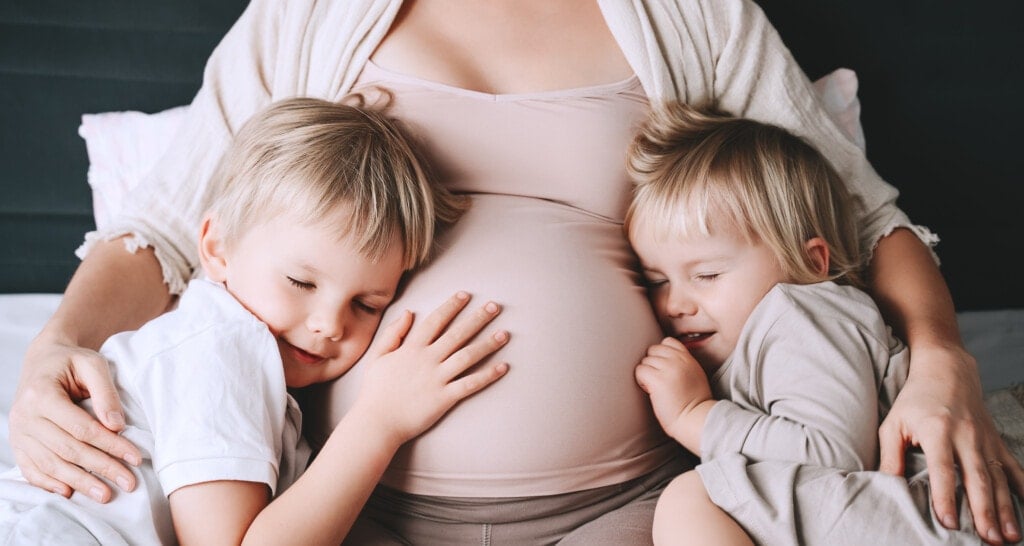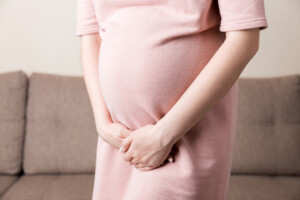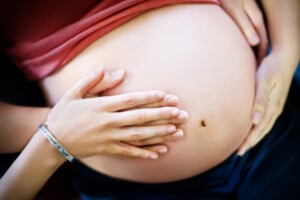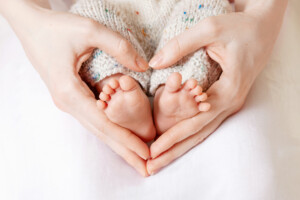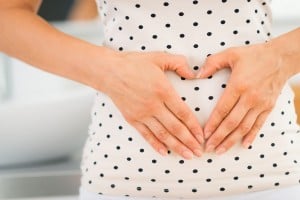Are you thinking of growing your family again? There is no universally correct answer regarding the right time to add another baby to your clan. But professional health organizations recommend waiting between 18 and 24 months after giving birth to get pregnant again.1 This is called the “interpregnancy interval.” The recommendation to space pregnancies this way aims to reduce the risk of poor maternal and infant outcomes. However, many couples delay their first child because of careers, finances, partner status, etc. This leaves less time in your childbearing years to space pregnancies, depending on your desired family size. There are also risks to waiting longer than five years between pregnancies.2, 3, 4
Although there is no perfect time to add another baby to your house, you should consider many factors before trying to conceive again. Ideal pregnancy spacing depends on maternal mental and physical health, previous pregnancy and birth history, age, fertility status, and family goals. The interval between a mother’s pregnancies can affect her health and the health of her future baby. This article outlines the benefits and risks of short and long interpregnancy intervals to help you and your partner decide the right pregnancy spacing for your circumstances.
Short Interpregnancy Interval (18 Months or Less)
There are increased physical risks for both mom and baby associated with becoming pregnant again less than 18 months after giving birth.8 The maternal depletion hypothesis is one theory as to why short pregnancy spacing may increase this risk.8 This idea theorizes that the physical demands of pregnancy and breastfeeding exhaust a mother’s nutrient stores, which need time to build up to support another pregnancy better. If these nutrients do not have time to replenish, their decreased availability may increase your chances of having a preterm delivery.
A short interpregnancy interval may also increase your risk of having a small-for-gestational-age or low birthweight baby.6 These outcomes may require a stay in the NICU for your little one. Short interpregnancy intervals are also associated with an increased risk of:
- stillbirth
- miscarriage
- placental bleeding disorders
- maternal death
- maternal anemia
- birth defects
- autism
- schizophrenia
Despite the risks associated with a shorter interpregnancy interval, there is debate whether the short spacing between pregnancies causes these risks or is just linked. It is also important to note that nothing magical happens when you reach 18-24 months postpartum, making your body ready for another pregnancy. Your body is gradually recovering from pregnancy, birth, and lactation. Each day, week, or month that goes by allows for more healing and replenishment of nutrients you may have depleted from your most recent baby.7
History of C-section
Achieving adequate pregnancy spacing is even more critical if your first or most recent birth was a Cesarean section. Women with a history of having a C-section that then has a short interpregnancy interval have an increased risk of placenta previa, placental abruption, and placenta accreta.2
During birth, mothers with less space between pregnancies also have an increased risk of uterine rupture, hemorrhage, transfusion, and maternal morbidity.2 Experts believe this is due to the Cesarean scar and uterus not completely healing. If you have had a C-section and hope to try labor or vaginal birth with a subsequent pregnancy (a VBAC), adequate pregnancy spacing is especially important.
The Emotional Component
In addition to the physical risks of a short interpregnancy interval, getting pregnant shortly after having a baby can cause a whirlwind of emotions. After all, your recent baby’s infancy is fresh on the brain, both the good (snuggles!) and the bad (sleep deprivation). Moms also report feeling guilt that their older child may have to grow up too quickly or that either child may not get as much attention as when there was just one.
Tips for Irish Twins
If you have a baby at home and are already pregnant with another baby, you may be worried about the physical and emotional toll that “two under two” may take on you and your family. Here are some things you can do:
Nourish Your Body
As mentioned in the depletion hypothesis, many nutrients such as folate, vitamin B6, and calcium may need to be replenished after pregnancy, especially during breastfeeding. Following a nutrient-rich diet is the best way to replenish these stores. Your provider or a nutritionist can help you create a meal plan that will help you with this.2
If you cannot achieve adequate nutrition from your diet, supplementing it with vitamins is a good idea. Most providers recommend continuing your prenatal vitamin during the postpartum and breastfeeding periods. Some companies also make specific postnatal vitamins focused on replenishing your nutrient stores. Keeping on top of your nutrition will help equip you to carry your next baby to term and recover postpartum.
Accept Help
Since you have already been through postpartum and the newborn phase, you know what to expect, and you may have more confidence in your ability to keep a tiny human alive this time. However, don’t let pride get in your way! Your hands will be doubly full with both a toddler and a newborn. Accept help from everyone. Have a list of tasks you can easily delegate to anyone who offers their time or assistance.
Prioritize
There will be times when your toddler and infant need you simultaneously. The best thing you can do is to prioritize health and safety. For instance, if your toddler is climbing the stair railing and your newborn is screaming, tend to the toddler first to prevent physical injury. Then once your toddler is in a safe place, you can tend to your crying newborn. Having this mental game plan in place for when you inevitably need to be in two places can help you strategize and prioritize.
Get Organized
Go through your toddler’s outgrown clothes, toys, and equipment, and identify what items you will use again and what you need to replace. Doing so will prepare the nursery and restock the drawers when your new little one arrives. It will also help you reminisce on the newborn days and get you excited to experience a tiny little one again when you may feel overwhelmed.
Prepare the Older Sibling
Tell your toddler about the baby and talk about the baby often. Share photos of your toddler when they were a baby and tell them how excited you were to welcome them to your family. Read books about being a big sibling and talk about ways your toddler can help with the baby. It is best not to make significant changes, such as potty training or changing bedrooms, in the three months before or after the baby’s birth.
Long Interpregnancy Interval (5+ Years Apart)
As with short interpregnancy intervals, extended intervals have benefits and risks. But if it is best to wait at least 18-24 months to get pregnant again, is it possible to wait too long to have another baby? That answer may be yes. There are also disadvantages to a long interpregnancy interval of five years or more.2
Physical Adaptations
Your body adapts to accommodate the baby inside you during your first pregnancy. New blood vessels grow to deliver increased blood flow to the uterus. These adaptations can benefit subsequent pregnancies because the uterus and placenta get more nutrients via more blood flow. As time passes from the first pregnancy, these physical changes slowly return to their pre-pregnancy state. A shorter time between pregnancies enables a woman’s body to take advantage of these helpful, temporary adaptations.
The regression of these adaptations may be why women with larger pregnancy spacing or age gaps are more likely to experience stalled dilation and stalled labor. So when a pregnancy is more than five years after a prior pregnancy, there is an increased risk of C-section due to failure to progress or dilate during labor. There is also an increased risk of preeclampsia in women with long interpregnancy intervals.2,3,4
It is important to note that these studies suggest the time between giving birth and getting pregnant again. However, they don’t factor in the time of conception or when to start trying for a new baby because it sometimes takes a while to get pregnant. By default, if you are delaying pregnancy, you are getting older! Older age is associated with increased time to conception.
If you desire more children, you do not want to wait too long to try for your next baby. Delaying childbearing requires balancing the risks of short pregnancy spacing with the risks of advanced maternal age and large pregnancy spacing. Maternal age can affect fertility status and chromosomal abnormalities. Waiting longer to conceive another child can also impact partner availability, finances, career, and illness.
Lifestyle and Siblings
Waiting longer to have another baby means you are more removed from the newborn experience and perhaps more out of practice. It may also mean that your older child is more set in their ways and established in their routine. A new baby could be a disruption to that schedule. Conversely, an older child has more ability to understand what it means to add a baby to the family. They may be more eager and able to help you with the baby.
Risks to Baby
Longer pregnancy spacing can affect not just the mother but also the baby. The younger child with a significant age gap may also have an elevated risk of certain disorders. For example, there is an increased risk of autism in babies conceived more than 60 months after their most recent older sibling’s birth.5 The risk of birth defects also increases with maternal age.
The research shows a “sweet spot” or an ideal interpregnancy interval between 18 and 60 months that allows you to heal from your last pregnancy and birth while taking advantage of the physiological adaptations of former pregnancies.2, 3 This window between 18 and 60 months may vary depending on your age, finances, family status, goals, etc.
You may feel ready for another baby or never feel totally ready. Having another child is simultaneously a huge decision and a leap of faith. Make sure you, your partner, and your provider are on the same page. Gather all the facts when deciding, but remember that it is normal to be nervous before pursuing this significant life change. Ultimately only you can decide that you are physically, mentally, and emotionally ready for another pregnancy and baby. Things work out no matter what you choose and when you conceive. Your new baby will be the perfect addition to your family at the perfect time—you won’t be able to imagine your family without them!























